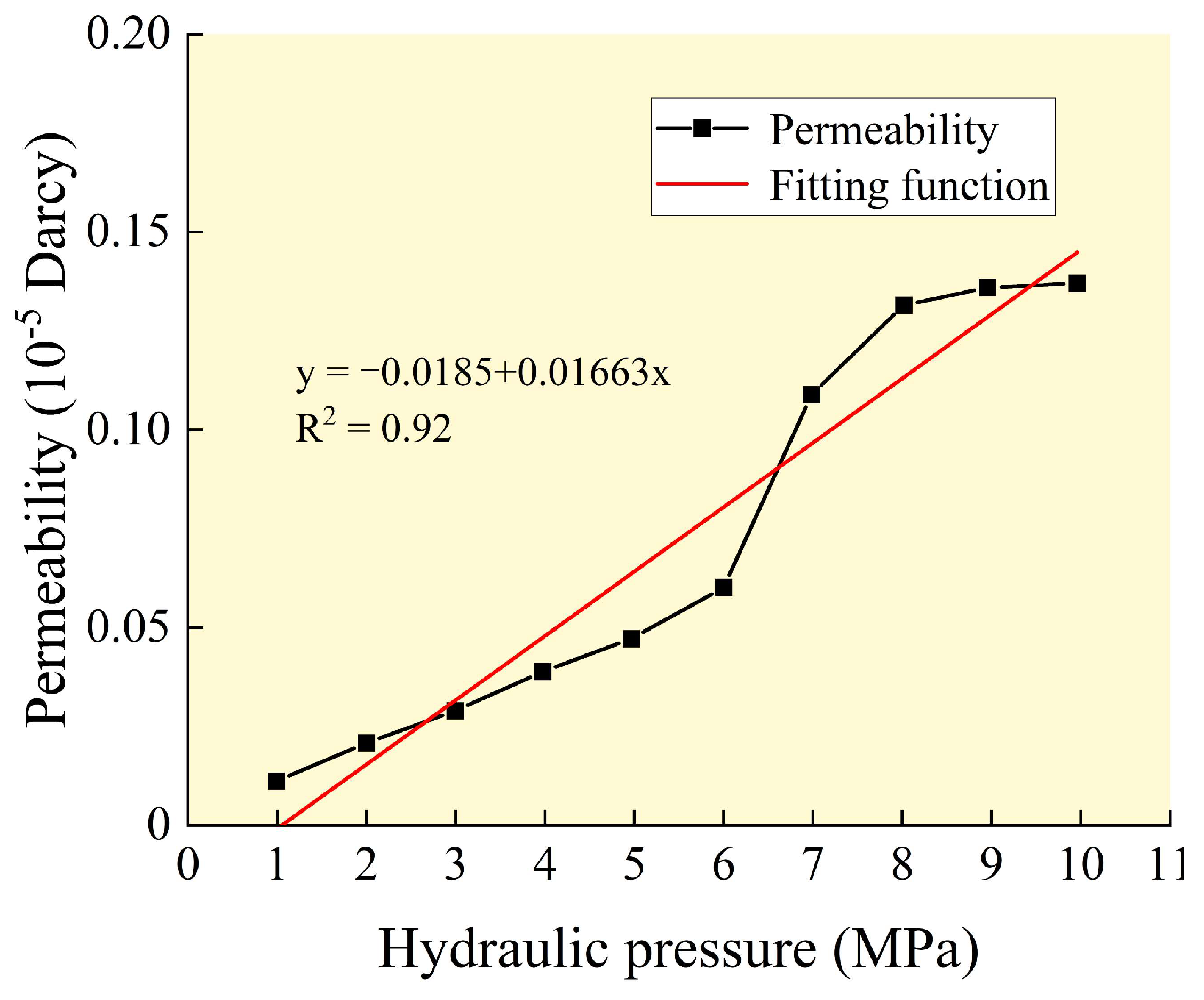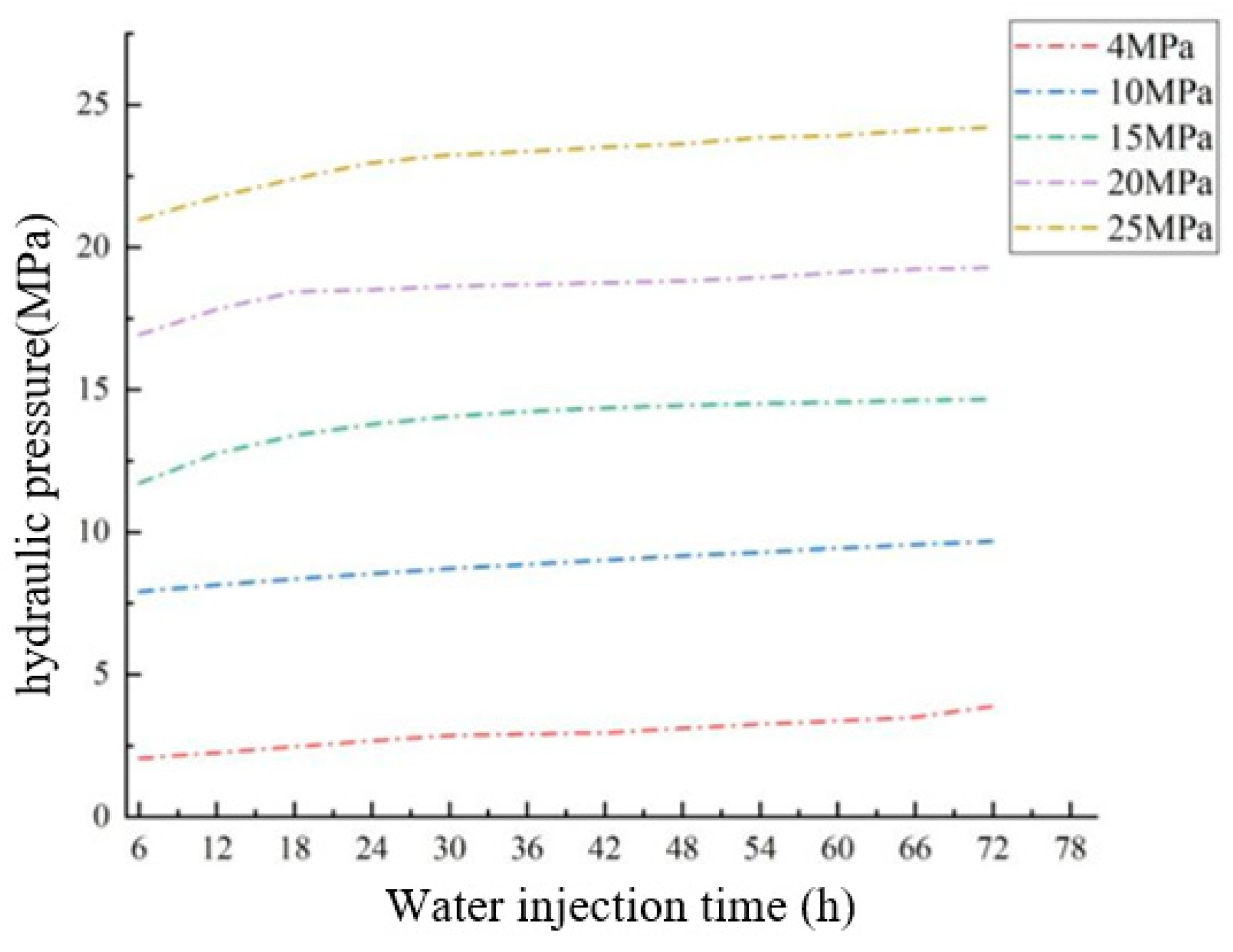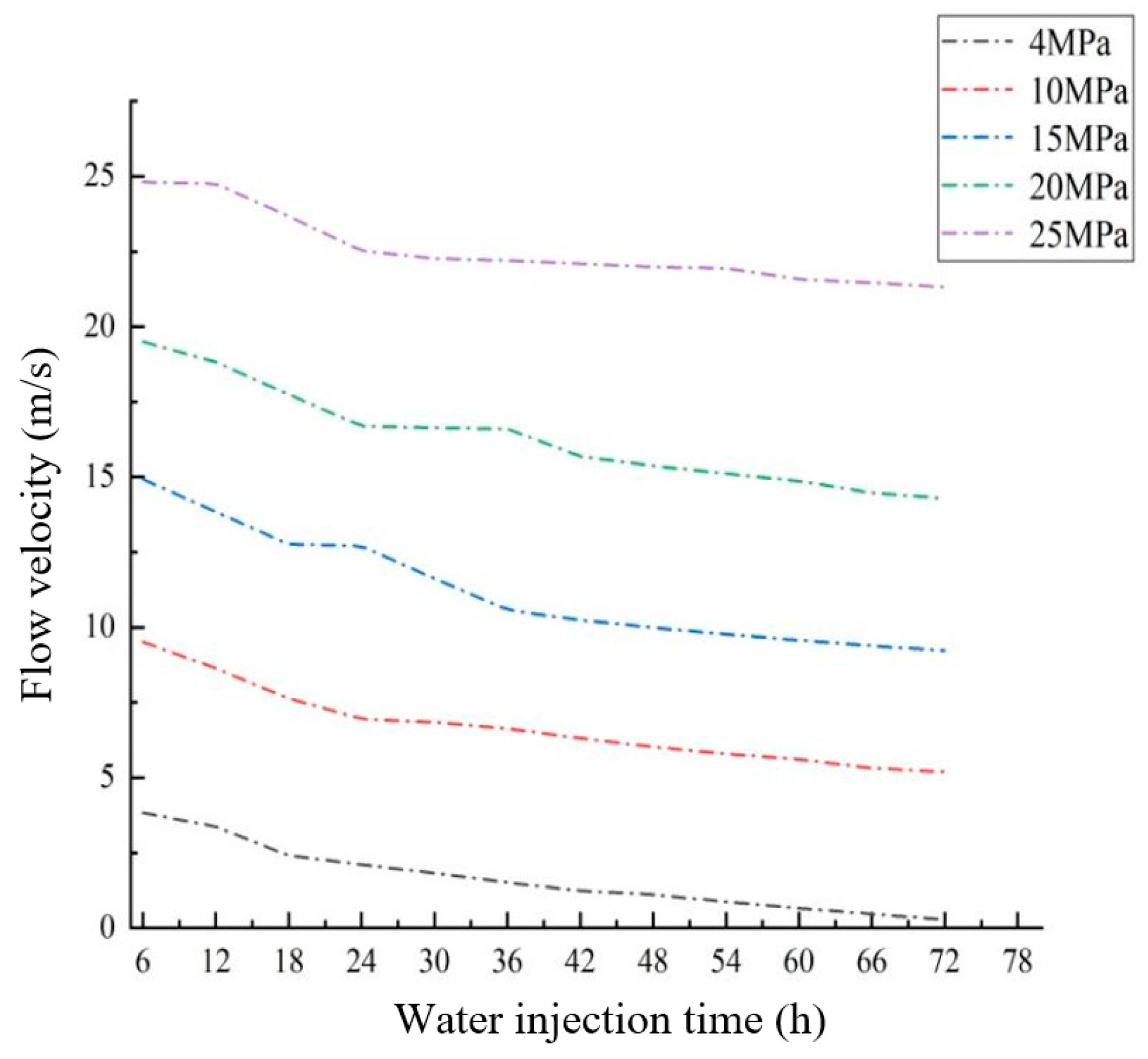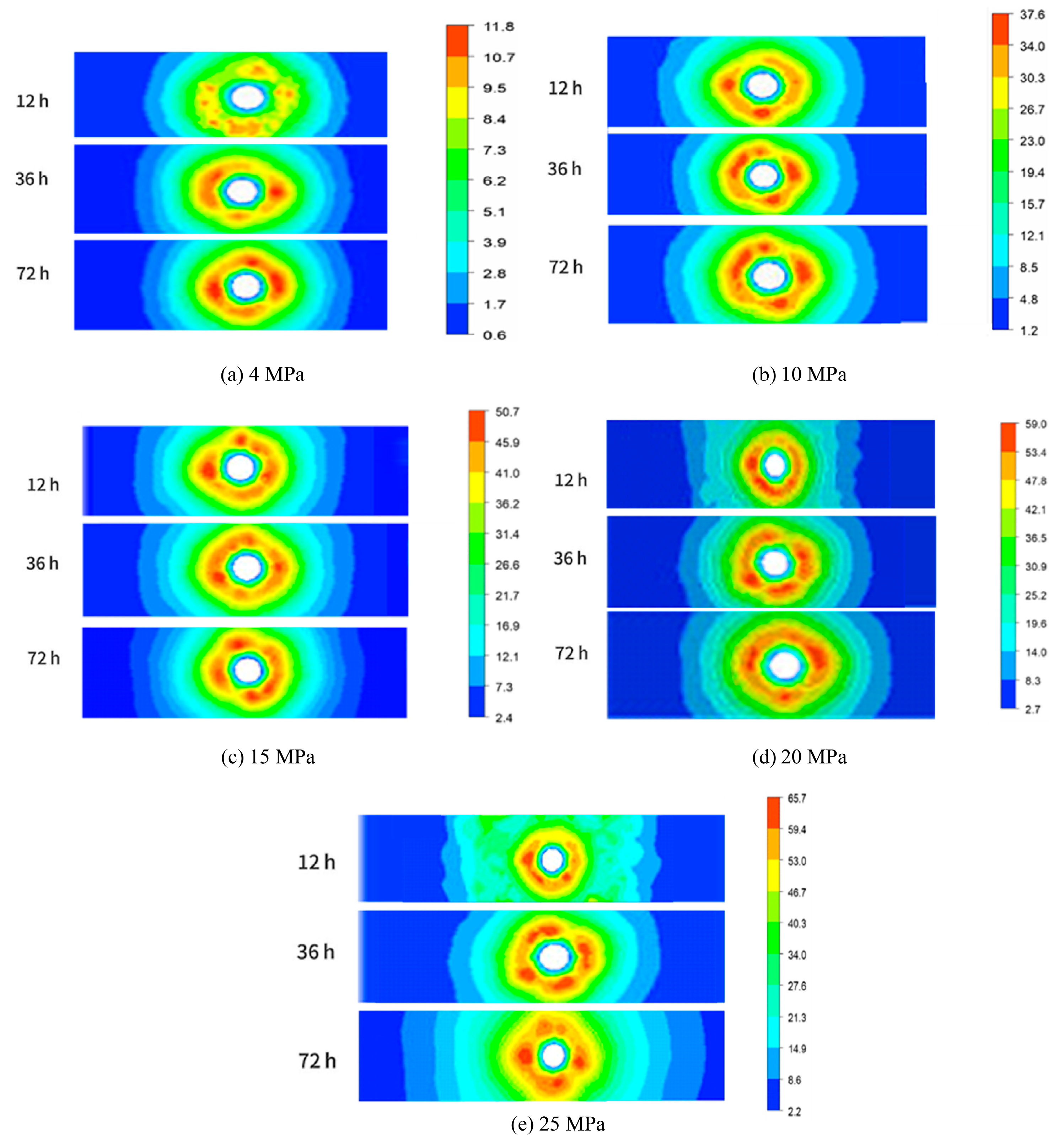Threshold Determination for Effective Water Injection in Coal Seams: Insights from Numerical Simulation
Abstract
:1. Introduction
2. Numerical Simulation Modeling and Boundary Conditions
2.1. Physical Model
2.2. Parameterization
3. Numerical Simulation Results and Analysis
3.1. Simulation Analysis of Radial Seepage Pressure Field of Coal Bed Water Injection Borehole under Different Pore Water Pressure
3.2. Analysis of Radial Seepage Velocity Field of Coal Bed Water Injection Borehole under Different Pore Water Pressure
3.3. Analysis of Water Distribution Law of Radial Seepage in Borehole under Different Pore Water Pressure
4. Conclusions
Author Contributions
Funding
Institutional Review Board Statement
Informed Consent Statement
Data Availability Statement
Conflicts of Interest
References
- Cai, P.; Nie, W.; Chen, D.; Yang, S.; Liu, Z. Effect of Air Flowrate on Pollutant Dispersion Pattern of Coal Dust Particles at Fully Mechanized Mining Face Based on Numerical Simulation. FUEL 2019, 239, 623–635. [Google Scholar] [CrossRef]
- Wang, P.; Tan, X.; Zhang, L.; Li, Y.; Liu, R. Influence of Particle Diameter on the Wettability of Coal Dust and the Dust Suppression Efficiency via Spraying. Process Saf. Environ. Protect. 2019, 132, 189–199. [Google Scholar] [CrossRef]
- Xiu, Z.; Nie, W.; Chen, D.; Yan, J.; Cai, P.; Liu, Q.; Wei, C. Numerical Simulation Study on the Coupling Mechanism of Composite-Source Airflow-Dust Field in a Fully Mechanized Caving Face. Powder Technol. 2019, 356, 443–457. [Google Scholar] [CrossRef]
- Liu, Z.; Nie, W.; Peng, H.; Yang, S.; Chen, D.; Liu, Q. The Effects of the Spraying Pressure and Nozzle Orifice Diameter on the Atomizing Rules and Dust Suppression Performances of an External Spraying System in a Fully-Mechanized Excavation Face. Powder Technol. 2019, 350, 62–80. [Google Scholar] [CrossRef]
- Wang, G.; Qin, X.; Shen, J.; Zhang, Z.; Han, D.; Jiang, C. Quantitative Analysis of Microscopic Structure and Gas Seepage Characteristics of Low-Rank Coal Based on CT Three-Dimensional Reconstruction of CT Images and Fractal Theory. Fuel 2019, 256, 115900. [Google Scholar] [CrossRef]
- Tao, M.; Li, Z.; Cao, W.; Li, X.; Wu, C. Stress Redistribution of Dynamic Loading Incident with Arbitrary Waveform through a Circular Cavity. Int. J. Numer. Anal. Methods Geomech. 2019, 43, 1279–1299. [Google Scholar] [CrossRef]
- Wang, P.; Tian, C.; Liu, R.; Wang, J. Mathematical Model for Multivariate Nonlinear Prediction of SMD of X-Type Swirl Pressure Nozzles. Process Saf. Environ. Protect. 2019, 125, 228–237. [Google Scholar] [CrossRef]
- Wu, M.; Hu, X.; Zhang, Q.; Xue, D.; Zhao, Y. Growth Environment Optimization for Inducing Bacterial Mineralization and Its Application in Concrete Healing. Constr. Build. Mater. 2019, 209, 631–643. [Google Scholar] [CrossRef]
- Chang, P.; Xu, G.; Zhou, F.; Mullins, B.; Abishek, S.; Chalmers, D. Minimizing DPM Pollution in an Underground Mine by Optimizing Auxiliary Ventilation Systems Using CFD. Tunn. Undergr. Space Technol. 2019, 87, 112–121. [Google Scholar] [CrossRef]
- Wang, J.; Zhou, G.; Wei, X.; Wang, S. Experimental Characterization of Multi-Nozzle Atomization Interference for Dust Reduction between Hydraulic Supports at a Fully Mechanized Coal Mining Face. Environ. Sci. Pollut. Res. 2019, 26, 10023–10036. [Google Scholar] [CrossRef]
- Liu, Q.; Nie, W.; Hua, Y.; Peng, H.; Liu, C.; Wei, C. Research on Tunnel Ventilation Systems: Dust Diffusion and Pollution Behaviour by Air Curtains Based on CFD Technology and Field Measurement. Build. Environ. 2019, 147, 444–460. [Google Scholar] [CrossRef]
- Zhou, W.; Nie, W.; Liu, C.; Liu, Q.; Wang, H.; Wei, C.; Yan, J.; Yin, S.; Xiu, Z.; Xu, C. Modelling of Ventilation and Dust Control Effects during Tunnel Construction. Int. J. Mech. Sci. 2019, 160, 358–371. [Google Scholar] [CrossRef]
- Li, Y.; Wang, P.; Liu, R.; Gao, R. Optimization of Structural Parameters and Installation Position of the Wall-Mounted Air Cylinder in the Fully Mechanized Excavation Face Based on CFD and Orthogonal Design. Process Saf. Environ. Protect. 2019, 130, 344–358. [Google Scholar] [CrossRef]
- Li, Y.; Wang, P.; Liu, R.; Jiang, Y.; Han, H. Determination of the Optimal Axial-to-Radial Flow Ratio of the Wall-Mounted Swirling Ventilation in Fully Mechanized Excavation Face. Powder Technol. 2020, 360, 890–910. [Google Scholar] [CrossRef]
- Han, H.; Wang, P.; Li, Y.; Liu, R.; Tian, C. Effect of Water Supply Pressure on Atomization Characteristics and Dust-Reduction Efficiency of Internal Mixing Air Atomizing Nozzle. Adv. Powder Technol. 2020, 31, 252–268. [Google Scholar] [CrossRef]
- Xu, C.; Nie, W.; Yang, S.; Peng, H.; Liu, Z.; Ma, Q.; Guo, C.; Liu, Q. Numerical Simulation of the Multi-Index Orthogonal Experiments on the Spray Dust-Settling Devices. Powder Technol. 2020, 371, 217–230. [Google Scholar] [CrossRef]
- Yin, S.; Nie, W.; Liu, Q.; Hua, Y. Transient CFD Modelling of Space-Time Evolution of Dust Pollutants and Air-Curtain Generator Position during Tunneling. J. Clean Prod. 2019, 239, 117924. [Google Scholar] [CrossRef]
- Amyotte, P.R.; Pegg, M.J.; Khan, F.I. Application of Inherent Safety Principles to Dust Explosion Prevention and Mitigation. Process Saf. Environ. Protect. 2009, 87, 35–39. [Google Scholar] [CrossRef]
- Wang, H.; Du, Y.; Wei, X.; He, X. An Experimental Comparison of the Spray Performance of Typical Water-Based Dust Reduction Media. Powder Technol. 2019, 345, 580–588. [Google Scholar] [CrossRef]
- Wang, H.; Xuan, W.; Zhang, Z.; Qin, B. Experimental Investigation of the Properties of Dust Suppressants after Magnetic-Field Treatment and Mechanism Exploration. Powder Technol. 2019, 342, 149–155. [Google Scholar] [CrossRef]
- Yin, W.; Zhou, G.; Gao, D. Simulation Analysis and Engineering Application of Distribution Characteristics about Multi-Stage Atomization Field for Cutting Dust in Fully Mechanized Mining Face. Adv. Powder Technol. 2019, 30, 2600–2615. [Google Scholar] [CrossRef]
- Liu, X.L.; Zhang, Z.Y.; Li, M.Q. Gray Comprehensive Evaluation Method on Coal Seam Water Injection in Order of Difficulty. In Proceedings of the 2016 International Conference on Electronic, Information and Computer Engineering, Hong Kong, Chin, 26–27 April 2016; Sung, W.P., Kao, J.C.M., Eds.; EDP Sciences: Les Ulis, France, 2016; Volume 44, p. 02049. [Google Scholar]
- Wu, Z.; Wang, J.; Wan, Z.; Cheng, J.; Xiong, L.; Zhao, L.; Liu, X. A Case Study of Cyclic Top Coal Weakening Process Based on Highly Tough Coal Seam with Partings. Shock Vib. 2021, 2021, 8862044. [Google Scholar] [CrossRef]
- Zhao, J.; Dong, Y.; Fu, J.; Zhao, L.; Zhang, Y. Design and Experiment of Energy-Saving Water Injection Pump. J. Pet. Explor. Prod. Technol. 2020, 10, 2127–2135. [Google Scholar] [CrossRef]
- Cui, M.; Jang, M.; Kang, K.; Kim, D.; Snyder, S.A.; Khim, J. A Novel Sequential Process for Remediating Rare-Earth Wastewater. Chemosphere 2016, 144, 2081–2090. [Google Scholar] [CrossRef] [PubMed]
- Huang, R.; Tao, Y.; Chen, J.; Li, S.; Wang, S. Review on Dust Control Technologies in Coal Mines of China. Sustainability 2024, 16, 4038. [Google Scholar] [CrossRef]
- Zhou, G.; Li, S.; Ma, Y.; Ding, J.; Zhang, M. Synthesis and Properties of a Reinforcing Dust-Cementing Material for Thin Spray-On Liners in Mine Roadways. Adv. Mater. Sci. Eng. 2019, 2019, 8486534. [Google Scholar] [CrossRef]
- Zhou, G.; Xu, M.; Fan, T. Numerical Simulation of Combined Water Injection in Deep Coal Seam and Its Field Application for Dust Suppression and De-Stressing: A Case Study at Dongtan Coal Mine, China. Geotech Geol. Eng. 2018, 36, 283–291. [Google Scholar] [CrossRef]
- Zhang, J.; Wang, R.; Yang, F.; Lei, W.; Feng, B.; Zheng, C.; Zhang, J.; Miao, Z. Discussion on the Mechanism of Coal and Gas Outburst Prevention and Control by the Coal Seam Water Injection. In Proceedings of the 2018 4th International Conference on Environmental Science and Material Application, Xi’an, China, 15–16 December 2018; IoP Publishing Ltd.: Bristol, UK, 2019; Volume 252, p. 052090. [Google Scholar]
- Liu, G.; Wang, Y.; Yin, H.; Ding, Y.; Lan, Y.; Yang, D. Determination of Gas-Water Seepage Characteristics with Consideration of Dynamic Pore-Throat Structure in a Tight Sandstone Gas Formation. Mar. Pet. Geol. 2022, 136, 105440. [Google Scholar] [CrossRef]
- Wang, H.; He, J.; Yang, J.; Wang, H.; Zhang, Y.; Cheng, S.; Nie, Z. Cracking and Improved Wettability of Coal through Liquid CO2 Cyclic Cold Soaking for Dust Prevention. Process Saf. Environ. Protect. 2023, 171, 751–762. [Google Scholar] [CrossRef]
- Sun, J.; Zhou, G.; Wang, C.; Liu, R.; Miao, Y. Experimental Synthesis and Performance Comparison Analysis of High-Efficiency Wetting Enhancers for Coal Seam Water Injection. Process Saf. Environ. Protect. 2021, 147, 320–333. [Google Scholar] [CrossRef]
- Sun, J.; Zhou, G.; Gao, D.; Wei, Z.; Wang, N. Preparation and Performance Characterization of a Composite Dust Suppressant for Preventing Secondary Dust in Underground Mine Roadways. Chem. Eng. Res. Des. 2020, 156, 195–208. [Google Scholar] [CrossRef]







| Parameter Indicator | Parameter Value | Parameter Unit |
|---|---|---|
| Water viscosity coefficient | 1.04 × 10−3 | Pa·s |
| Water density | 1.0 × 103 | kg/m3 |
| Absolute permeability of coal seam | 7.526 × 10−18 | m2 |
| Initial porosity of coal bed | 6.3586 | % |
| Density of coal seam | 1.43 × 103 | kg/m3 |
| Poisson’s ratio | 0.32 | / |
| Modulus of elasticity of coal seam | 2.6 × 103 | MPa |
| Tensile strength | 1.0 × 104 | Pa |
Disclaimer/Publisher’s Note: The statements, opinions and data contained in all publications are solely those of the individual author(s) and contributor(s) and not of MDPI and/or the editor(s). MDPI and/or the editor(s) disclaim responsibility for any injury to people or property resulting from any ideas, methods, instructions or products referred to in the content. |
© 2024 by the authors. Licensee MDPI, Basel, Switzerland. This article is an open access article distributed under the terms and conditions of the Creative Commons Attribution (CC BY) license (https://creativecommons.org/licenses/by/4.0/).
Share and Cite
Liu, L.; Huang, G.; Zhao, Y. Threshold Determination for Effective Water Injection in Coal Seams: Insights from Numerical Simulation. Appl. Sci. 2024, 14, 8613. https://doi.org/10.3390/app14198613
Liu L, Huang G, Zhao Y. Threshold Determination for Effective Water Injection in Coal Seams: Insights from Numerical Simulation. Applied Sciences. 2024; 14(19):8613. https://doi.org/10.3390/app14198613
Chicago/Turabian StyleLiu, Lei, Gun Huang, and Yunfei Zhao. 2024. "Threshold Determination for Effective Water Injection in Coal Seams: Insights from Numerical Simulation" Applied Sciences 14, no. 19: 8613. https://doi.org/10.3390/app14198613






